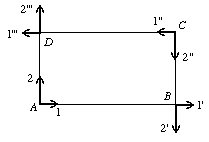To prove that, write f1 = Ta ∘ L ∘ T-a and f2 = Tb ∘ L' ∘ T-b and note that if α = -β then L' = L -1.
Then f1∘ f2 = a + L(-a + b + L -1(-b + x)) = a + L(b - a) - b + x which is translation by the vector a + L(b - a) - b
If the lines meet then their intersection is a fixed point for the composition and so this is a rotation. If they are parallel the product is a translation by twice the distance between them.
A glide reflection f is Ta ∘ Rl = Rl ∘ Ta.
So the product f1∘ f2 = (Ta ∘ Rl) ∘ (Tb ∘ Rm) = Ta ∘ (Rl ∘ Rm) ∘ Tb and so is a rotation if the lines l, m meet (by twice the angle between them) and a translation if they are parallel.
If a
 l, then write the rotation about a as the product of reflection in a line m parallel to l and reflection in a line n.
l, then write the rotation about a as the product of reflection in a line m parallel to l and reflection in a line n. So f = Rl ∘ Rota = Rl ∘ Rm ∘ Rn = Tb ∘ Rn where b is a vector perpendicular to l. Thus since b is not perpendicular to n, this is a glide reflection by the lemma proved earlier.
As in the last question, the condition is that a ∈ L.
Note that H0 is the map x
 -x and so Ha maps a + x to a - x.
-x and so Ha maps a + x to a - x.So acting on a - b + c with Hc maps it to -a + b + c and then acting on this with Hb gives a + b - c and acting on this with Ha gives a - b + c again. So this is a fixed point and since the composition of three half-turns is rotation by 3π which is the same as π the result is a half-turn about this point.
 and so this matrix maps the line y = 1 to itself. Identifying this matrix with the isometry f(x) = ±x + a gives the isomorphism with I(R).
and so this matrix maps the line y = 1 to itself. Identifying this matrix with the isometry f(x) = ±x + a gives the isomorphism with I(R).Similarly the matrix
 acts on a vector f the form
acts on a vector f the form  to give another such vector. Hence the matrix
to give another such vector. Hence the matrix  corresponds to the isometry of R2 given by Ta∘ L where a = (a1, a2) and A is the matrix of L ∈ O(2).
corresponds to the isometry of R2 given by Ta∘ L where a = (a1, a2) and A is the matrix of L ∈ O(2).
 Look at the picture:
Look at the picture:
Start with a pair of axes: 1 and 2 and follow their images under the glides.
 The composite of a pair of glides is a rotation (about some point) by twice the angle between them.
The composite of a pair of glides is a rotation (about some point) by twice the angle between them.
So GBC ∘ GAB = rotation by 2β and GDA ∘ GCD = rotation by 2 .
.
So if 2β + 2 ≠ 2π the composite cannot be the identity.
≠ 2π the composite cannot be the identity.
If β +  = π then since A is fixed by the composite, we do have the identity.
= π then since A is fixed by the composite, we do have the identity.
This is the condition that the quadrilateral is cyclic (the four vertices lie on a circle).
If h, k are both rotations then their inverses are rotations by the opposite amount and so (by Question 1 above) when we compose we get a translation. The same thing happens if one is a translation. If both are translations, they commute and we have the identity.
If f is a rotation about a by θ then take h, k to be reflections in lines meeting at a at an angle of α. Then f ∘ g is rotation by 2α and since h = h -1 and k = k -1 we have h ∘ k ∘ h -1 ∘ k -1= rotation by 4α and so we may take α = θ/4.
To get a translation by a, take h to be rotation by π about 0 and take k to be rotation by π about a/4.